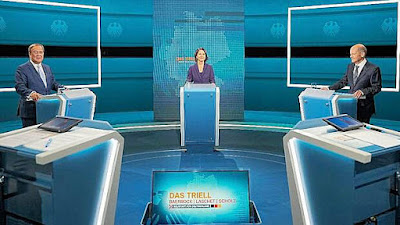The three parties likely to become the strongest in the new Bundestag (parliament) as the result of the upcoming federal elections on September 26 have sent candidates into the race for chancellor knowing that elections are decided mainly by personalities.

|
| The Triell at the Berlin Adlerhof studios (©WIWO) |

|
|
The result of a poll taken following the debate. Who is the winner? (©RTLaktuell) |
 |
| Kanzlerdämmerung. Chancellor Merkel last week at the Bundestag in Berlin. After 16 years, Goodbye, Angela, many will miss you (©Filip Singer/EPA). |

|
| ©CDU |
The ruling Christian Democrats are on the defensive, but instead of Konrad Adenauer's successful slogan of 1957, "No experiments," ...

|
| ©dpa |
... they get the red socks of 1994 from behind the oven painting a
left-wing coalition on the wall, including Die Linke. However, this option does not frighten the voter with Olaf Scholz at the helm.
No party will gain more than 50% of the seats in the next Bundestag, so coalitions must be formed. Here is the play of colors for possible constellations:
|
|
|
Projected number of seats in the future Bundestag considering recent results of polls (©Der Spiegel) |
As you may see from the graph, several coalitions have a majority of seats possible.
Some color combinations form state governments, e.g., a Kenia coalition in
Saxonia ...
P.S.: September 1. From the New York Times article, It's Election Season in Germany. No Charisma, Please!:

|
| ©NABU |
... or a Jamaica coalition in Schleswig-Holstein.

|
| ©CDU |
Last March, voters in the state of Rhineland-Palatinate confirmed a successful traffic light coalition. Too many people did not like the CDU pulling the plug.
The Grand Coalition has governed Germany since 2013 and is likely to have no majority in the new Bundestag. It needs at least three parties to form a government.

|
| The protagonists of CDU, SPD, and FDP (©Die Welt) |
So a novelty would be a "Germany coalition" between CDU, SPD, and FDP.
Will there be a significant shift in party preferences until September 26? I
doubt.
Less than a month before the vote on September 26, the field is being led by two male suit-wearing career politicians — one balding, one bespectacled, both over 60 — who represent the parties that have governed the country jointly for the better part of two decades.
*


No comments:
Post a Comment